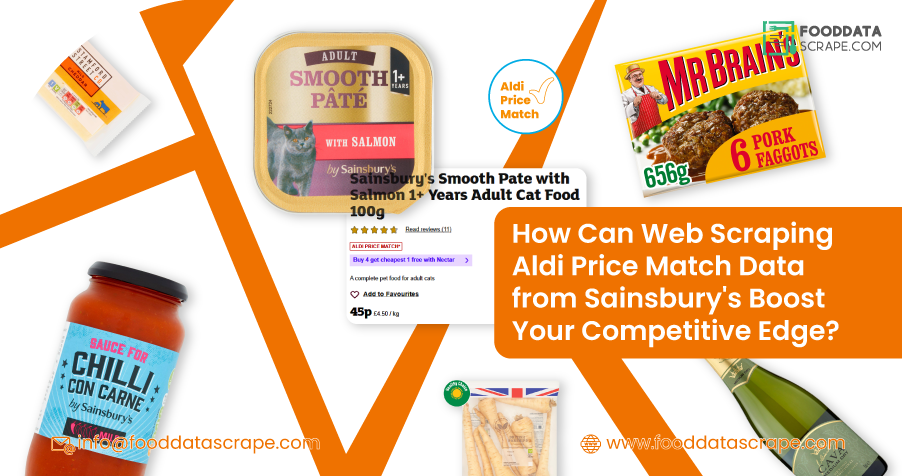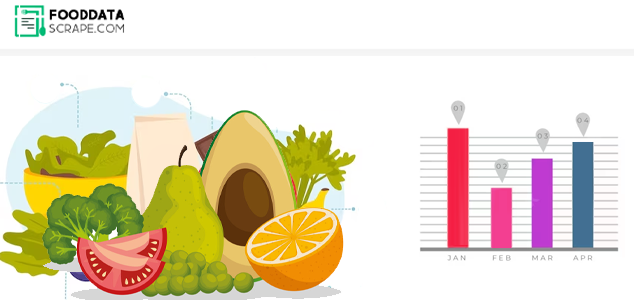Introduction
In the competitive UK grocery market, pricing strategies are crucial for winning customer loyalty. One prominent tactic is price matching. Sainsbury's Aldi Price Match stands out as a strategic move where Sainsbury's aligns prices of selected everyday items with those at Aldi, a well-known discount retailer. This initiative helps Sainsbury's attract budget-conscious shoppers without compromising on quality. Analyzing this strategy for businesses, data analysts, and even consumers offers valuable insights into pricing dynamics and market competition. Many rely on Web Scraping Aldi Price Match Data from Sainsbury's to track real-time changes and stay ahead. Through automation, it's possible to Extract Sainsbury's Aldi Price Match Products and monitor trends, promotional shifts, and product positioning. Whether you're a competitor, supplier, or researcher, being able to Scrape Aldi Price Match Product Data from Sainsbury's enables smarter decision-making and a deeper understanding of consumer value strategies in the retail space.
What is Aldi Price Match?
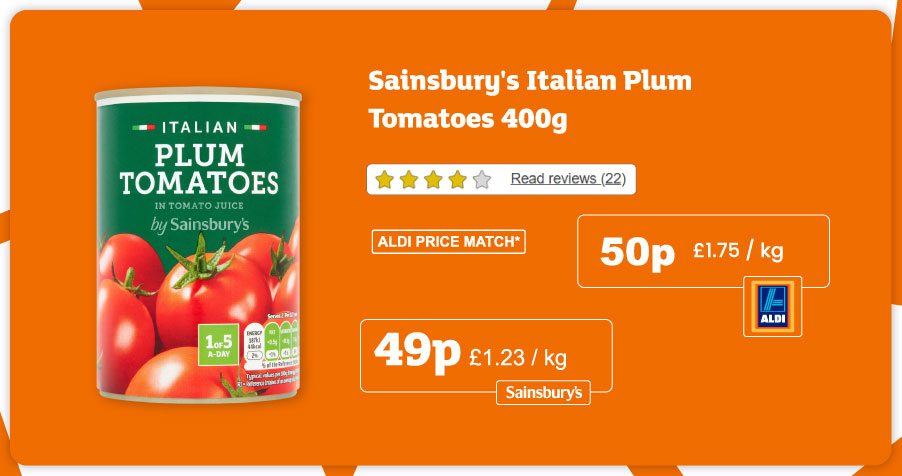
The Aldi Price Match is a smart pricing strategy adopted by UK retailers like Sainsbury's to stay competitive with Aldi's low-cost offerings. Introduced in 2021, this initiative allows Sainsbury's to match the prices of selected everyday essentials, especially fresh produce, meat, and household items. Extract Aldi Price Comparison Data from Sainsbury's to understand how these prices align across both retailers.
Sainsbury's updates this pricing regularly, reflecting market shifts and ensuring affordability. Labels marked "Aldi Price Match" are displayed in-store and online. Track Sainsbury's Price Match Promotions to keep an eye on changing product prices and offers that appeal to value-conscious consumers.
The strategy aims to retain customer loyalty and reduce shopper migration to discount chains. It signals that quality doesn't have to come at a higher cost. Scrape Data from Sainsbury's - UK Supermarket to analyze how this approach affects pricing trends and consumer behavior.
What Does Aldi Price Match Include?
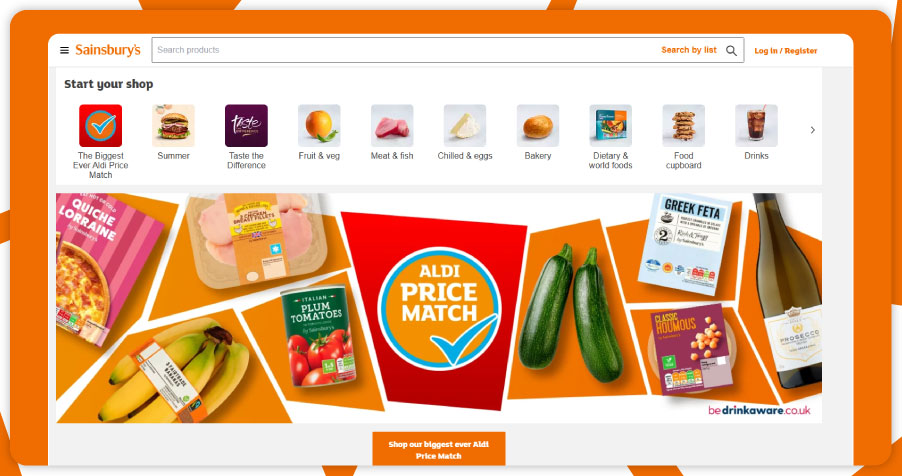
The range of products included in Sainsbury's Aldi Price Match covers:
1. Fresh Produce
- Carrots, potatoes, onions, cucumbers, tomatoes
- Apples, bananas, oranges
2. Meat and Poultry
- Chicken breast fillets, minced beef, sausages, bacon
3. Dairy Products
- Milk, butter, cheese, eggs, yogurts
4. Pantry Staples
- Baked beans, tinned tomatoes, pasta, rice, cereals
5. Frozen Foods
- Frozen chips, vegetables, pizzas
6. Household and Toiletries
- Washing up liquid, toilet paper, bin bags
The exact products in the Aldi Price Match list change frequently as market prices shift. Sainsbury's continuously monitors Aldi's prices and adjusts its list accordingly, so having up-to-date data is critical for analysis.
This selection targets everyday essentials, ensuring shoppers notice the savings and make price comparisons when choosing between supermarkets.
Unlock actionable pricing insights today—contact us to start scraping valuable data for your business success!
Why Did Sainsbury's Introduce Aldi Price Match?
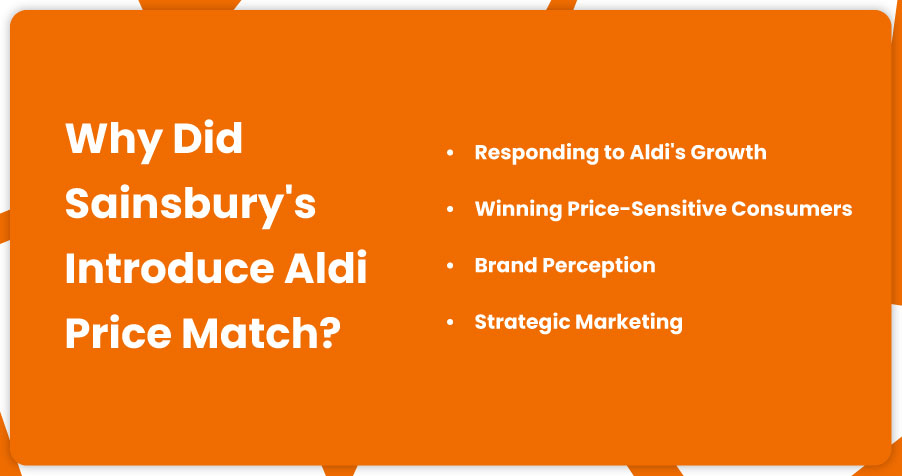
Sainsbury's introduced the Aldi Price Match strategy to stay competitive amidst Aldi's rapid growth. By matching prices on essential products, Sainsbury's aims to retain budget-conscious shoppers, maintain market share, and strengthen its position as a value-driven retailer.
- Responding to Aldi's Growth: Aldi's rapid market share expansion in the UK has significantly pressured traditional supermarkets. Its reputation for low-cost groceries and a streamlined, no-frills shopping experience has drawn millions of cost-conscious shoppers. Sainsbury's adopted the Aldi Price Match strategy to stay relevant in this evolving retail landscape. To analyze how this strategy works, businesses can Scrape Online Sainsbury's Grocery Delivery App Data and gain insight into pricing trends and competitive shifts.
- Winning Price-Sensitive Consumers: Amid rising inflation and economic challenges, affordability is now a top priority for many households. Sainsbury's Aldi Price Match initiative helps retain price-conscious customers who may be tempted to switch to discounters. Collecting and analyzing Online Groceries Dataset From Sainsbury's can offer a clearer picture of how effectively this strategy attracts and retains shoppers in the current economic climate.
- Brand Perception: By matching Aldi's prices, Sainsbury's sends a clear message: shoppers can enjoy quality and value under one roof. This approach not only attracts budget-minded families but also enhances brand perception. Analysts and retailers can use Sainsbury's Grocery Delivery Scraping API Services to track how product pricing aligns with consumer sentiment and brand positioning over time.
- Strategic Marketing: The "Aldi Price Match" label is more than just a price tag—it's a marketing statement. Displayed prominently both in stores and online, it fosters a sense of trust and transparency. Shoppers feel confident that they're getting a competitive deal without compromising quality. Businesses looking to evaluate this initiative's impact can Scrape Sainsbury's Product Data to monitor promotional patterns, product assortments, and pricing consistency across platforms.
Why Web Scrape Aldi Price Match Data from Sainsbury's?
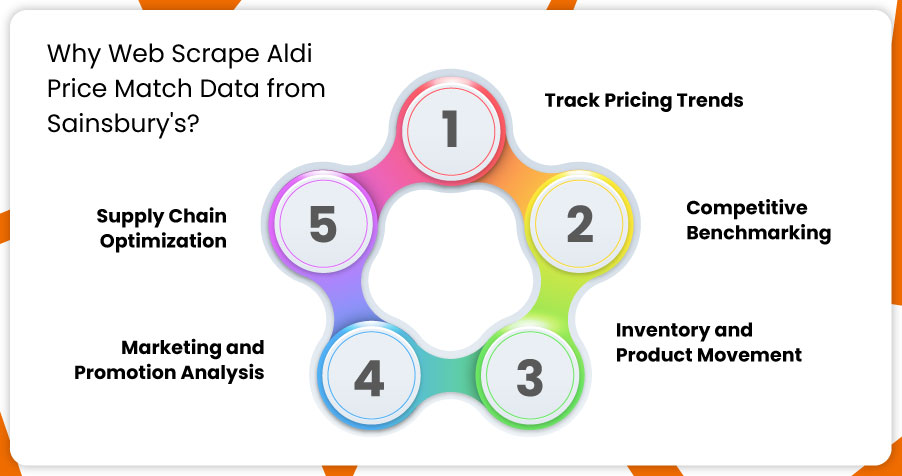
Understanding the Aldi Price Match strategy goes beyond headlines—it requires real-time, structured, and scalable data analysis. This is where web scraping becomes essential, offering critical insights through automated data collection. Businesses can rely on Grocery App Data Scraping Services to systematically extract Sainsbury's product listings, pricing, and promotions.
- Track Pricing Trends: With historical pricing data collected via scraping, analysts can observe how often Sainsbury's adjusts prices to match Aldi and which product categories are impacted most. This insight fuels Web Scraping Quick Commerce Data strategies for fast decision-making in dynamic retail environments.
- Competitive Benchmarking: Companies can evaluate pricing precision and competitive alignment by comparing Sainsbury's Aldi Price Match items to Aldi's actual prices. Leveraging Grocery Delivery Scraping API Services allows real-time comparisons and deeper market analysis.
- Inventory and Product Movement: Frequent updates in the matched item list reveal demand patterns and help businesses understand inventory cycles. This data feeds directly into a Grocery Price Dashboard , making trends easier to visualize.
- Marketing and Promotion Analysis: Scraping also uncovers how Sainsbury's promotes these matched items online, primarily through digital signage and product descriptions. This supports the creation of a robust Grocery Price Tracking Dashboard to track campaign effectiveness.
- Supply Chain Optimization: Suppliers gain a competitive edge by using this data to adjust pricing, forecast demand, or negotiate deals. With accurate Grocery Pricing Data Intelligence , they can tailor their strategies for retailers engaged in price-matching models.
How to Web Scrape Aldi Price Match Data from Sainsbury's
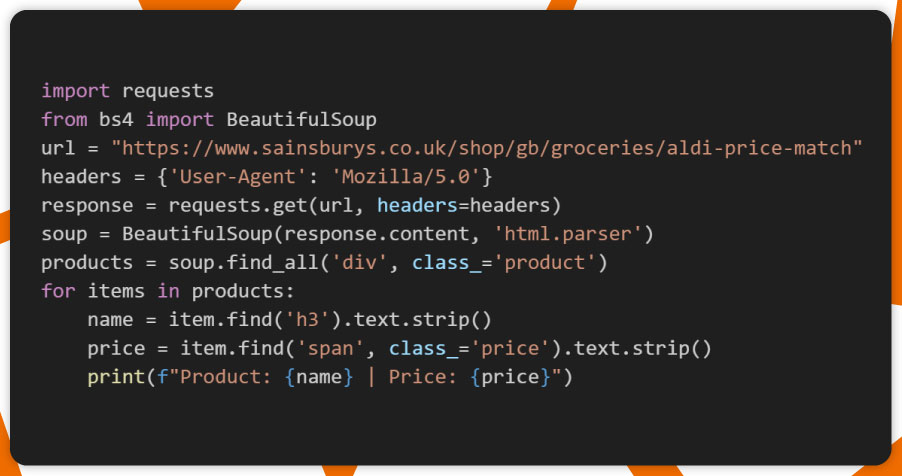
To collect data on Aldi Price Match products from Sainsbury's, follow these general steps:
Step 1: Identify Target URLs
Navigate to Sainsbury's official website and locate the "Aldi Price Match" section, which may have a dedicated page or tag. Identify product listing URLs.
Step 2: Inspect the Web Page Structure
Use developer tools (F12 on Chrome) to inspect product cards, price tags, product names, and labels (e.g., "Aldi Price Match").
Step 3: Build a Scraper Using Python
You can use libraries like Requests, BeautifulSoup, or Selenium to fetch and parse the HTML content. Here's a simple code snippet:
Step 4: Schedule Periodic Scraping
Use tools like cron (Linux), Windows Task Scheduler, or cloud-based platforms to run your scraper weekly or daily and capture updated prices.
Step 5: Store and Analyze Data
Export the data to a database, Excel, or CSV for further analysis. Using tools like Power BI or Tableau, you can track changes over time and visualize trends.
Ethical and Legal Considerations

While scraping publicly available data from retail websites is generally considered legal, there are a few ethical and legal points to keep in mind:
- Respect the site's robots.txt: This file provides guidelines for web crawlers.
- Avoid high-frequency scraping: It may slow down the site or block your IP.
- Use proper attribution if republishing insights or data.
- Don't scrape login-restricted content or personal customer data.
The Bigger Picture: Using Price Match Data for Business Intelligence

Scraping Aldi Price Match data from Sainsbury's is just one aspect of a broader pricing intelligence strategy. Retailers and data-driven companies can combine this with data from Tesco, ASDA, and Morrisons to form a comprehensive pricing landscape.
Key use cases include:
- Retail consulting firms offering price competitiveness analysis
- CPG brands adjusting their pricing strategy to match retailer positioning
- Financial analysts evaluating market strategy for retail investments
- Consumer behavior researchers tracking responses to pricing campaigns
How Food Data Scrape Can Help You?
- Automated Data Collection: We provide scalable web scraping solutions that automatically extract real-time pricing data from grocery platforms like Sainsbury's, Aldi, and others, eliminating manual tracking and reducing errors.
- Customizable Pricing Dashboards: Clients receive structured data integrated into custom Grocery Price Dashboards, enabling them to monitor competitor prices, spot trends, and make confident pricing decisions.
- Category-Level Price Intelligence: Our tools track price changes across specific categories—like fresh produce, meat, or household essentials—giving clients granular insights to refine their product strategies.
- Historical Price Tracking: We store and maintain time-stamped data, allowing clients to view historical trends and measure the effectiveness of past promotions using Grocery Price Tracking Dashboards.
- Competitive Benchmarking: Our services allow businesses to compare their prices against competitors like Aldi by leveraging Grocery Store Datasets, enhancing their ability to stay competitive in a dynamic market.
Conclusion
Strategic marketing is crucial in understanding how pricing tactics like Aldi Price Match influence consumer behavior and brand perception. For businesses, suppliers, and analysts, staying updated with this data provides valuable insights into market behavior, brand positioning, and customer value perception. Access to accurate and timely information is key—and that's where web scraping proves indispensable.
Web scraping offers the ability to automate and scale this intelligence gathering, turning raw online data into meaningful, actionable insights. With tools that extract real-time pricing and promotional data, organizations can better understand how Sainsbury's competes in today's price-sensitive market. Leveraging Grocery Store Datasets allows retailers, researchers, and data analysts to track trends, identify opportunities, and stay ahead of competitors.
Whether you're a retailer fine-tuning your pricing strategy, a researcher studying retail trends, or a data enthusiast exploring consumer economics, extracting Aldi Price Match data from Sainsbury's puts you at the heart of one of the retail industry's most dynamic pricing battles.
Are you in need of high-class scraping services? Food Data Scrape should be your first point of call. We are undoubtedly the best in Food Data Aggregator and Mobile Grocery App Scraping service and we render impeccable data insights and analytics for strategic decision-making. With a legacy of excellence as our backbone, we help companies become data-driven, fueling their development. Please take advantage of our tailored solutions that will add value to your business. Contact us today to unlock the value of your data.






















































































